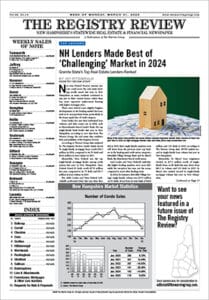
Banks across the state are trying to figure out what to do with the roughly $8.44 billion increase in customer deposits statewide caused by the COVID-19 pandemic.
While excess deposits are far from a banker’s primary concern, they can become problematic when there’s nowhere to deploy them, a situation many banks find themselves in as credit has tightened and business lending customers tighten their own belts due to an uncertain economic future.
But despite huge growth in deposits over the last year, banks across the state say they are finding ways to put their capital to work.
Total deposits in New Hampshire grew to roughly $42.4 billion at the end of June of this year, according to the FDIC, a nearly 20 percent increase from June of 2019. The nation’s banking system has been flooded with deposits as a result of government stimulus efforts, money leaving the markets, and changing consumer spending habits. Initiatives like the Paycheck Protection Program, the $1,200 federal aid checks and enhanced unemployment benefits have added to customer deposit balances.
Consumers are also holding more money than they used to. The personal savings rate in the U.S., the percentage of people’s incomes left after they pay taxes and spend money, hit 14.1 percent in August, up nearly double from a year ago, although down from earlier this year.
“People’s spending habits have changed during the crisis,” said Bob Montgomery-Rice, president and CEO of Bangor Savings Bank. “They are not spending at the same level: They are not going on vacation, they are not going out to eat as much as they used to, they can’t go shopping as much as they used to and so banks across the country have all sort of seen their deposits balloon.”
Bangor Savings Bank, which is based in Maine but broke into the New Hampshire market with its purchase of Granite Bank in 2018, saw deposits in New Hampshire grow to more than $260 million at the end of June in 2020, according to the FDIC. That’s up 35 percent year-over-year and now gives Bangor Savings Bank 0.61 percent deposit market share in New Hampshire.
Montgomery-Rice said while the bank did do a lot of PPP loans, about $28 million of that deposit growth was not PPP related, meaning it’s likely from a mixture of stimulus checks, increased consumer savings, and organic growth.
The bank has been effective in deploying that money, Montgomery-Rice said, originating about $1 billion in residential mortgage loans across its footprint through the first six months of the bank’s fiscal year, which begins April 1. That’s a large amount considering the bank only originated $700 million in residential lending volume in the entire prior fiscal year.
Residential lending has benefitted from the Federal Reserve lowering its benchmark lending rate rapidly from 2 percent to near zero in March, but also as a result of wealthy homebuyers from urban areas like New York City and Boston flooding rural areas and vacation spots looking for a bucolic retreat during the pandemic.
Commercial Assets Grow
Montgomery-Rice said he has not seen a lot of asset growth on the commercial side due to the pandemic.
But other banks in New Hampshire say they are seeing activity in that space.
Ron Magoon, president and CEO of Franklin Savings Bank, said the bank during its most recent fiscal year, easily exceeded its budget and projections on both commercial and residential lending.
The bank grew deposits 17 percent between June of 2019 and June of this year, according to the FDIC. The bank now holds close to $525 million deposits in New Hampshire and a 1.24 percent deposit market share, and according to Magoon, has had no trouble finding demand for commercial loan activities whether it’s a line of credit or a developer working on a housing development.
“What we’ve seen is that economy and certainly at least in New Hampshire, if we are talking about Franklin Savings Bank, the economy here has held up a heck of a lot better than we thought it would,” Magoon said. “I think we’ve recovered quicker and I think we’ve recovered at a more significant pace than we thought would happen.”
Banks Win Either Way
Magoon said he thinks the build-up of excess deposits could stick around for a while as people continue to stay conservative as coronavirus cases rise in some areas of the country, creating the potential for a second wave of infections.
While the excess liquidity isn’t a problem while loan demand is available, it could be a more of a challenge if that activity dries up because investment securities aren’t offering much of a return in this low-rate environment.
However, if the deposits continue to be mostly from non-interest–bearing sources and loan activity holds steady, Montgomery-Rice sees the increase in deposits as a boon right now for banks.
“Sometimes bankers might tell you, ‘I got too many deposits,’ and I would tell you: You can never have too many deposits,” he said. “Growing depository relationships are very, very important. It keeps your funding costs low. If you can be people’s primary bank when it comes to their core, it will bode well for you as a bank.”

